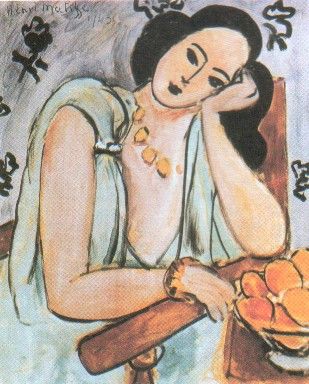Description
Henri Matisse, a towering figure in modern art, offers us in his work "Monique Bourgeois, 1943" a vibrant testimony to his mastery in exploring color and the human form. Painted during World War II, this portrait captures not only the physical likeness of Monique Bourgeois, an exuberant young woman who would later become Sister Jacques-Marie, but also the persistence of beauty and life in times of adversity.
The work, presented in a 31x39 cm format, is an intimate and reflective portrait. It confronts us with a young woman with a serene face and introspective gaze. In terms of composition, Matisse employs a simplicity that borders on abstraction, focusing our attention on the central figure without distractions from the background, which remains neutral and blurred. The economy of details in the environment allows Monique's features to emerge with particular strength. The artist uses confident and deliberate strokes, characteristics that define his mature style.
The use of color in "Monique Bourgeois, 1943" is especially significant. Matisse applies a palette dominated by soft and earthy tones, with touches of pink and brown that animate the young woman's flesh. This chromatic approach not only brings the portrait to life but also conveys an atmosphere of calm and spirituality. The subtlety in the variation of tones indicates a refined technique that seeks to capture light and shadow in an almost tactile manner.
Monique Bourgeois herself is a figure that transcends the mere condition of a model. Her relationship with Matisse developed during a period of the artist's convalescence, and their bond endured beyond this portrait. The young nurse, who became a Dominican nun, inspired Matisse in some of his most important and spiritual projects, including the Chapel of the Rosary in Vence. This portrait, therefore, is more than a pictorial record; it is a document of a complex and rich human and intellectual relationship.
"Monique Bourgeois, 1943" is also distinguished by its ability to suggest a narrative without the need for explicit elements. The work captures a moment frozen in time, a reflective pause that invites the viewer to contemplate not only the exteriority of the figure but to penetrate her inner world. Here, the influence of techniques that Matisse developed throughout his career is perceived, where each line and color seem to breathe almost on their own, endowing the figure with a vibrant presence.
Matisse's work, and specifically this portrait, reminds us of the importance of the creative process as an act of resistance and renewal. Through colors that seem like whispers and forms that are almost caresses, the artist revealed the deepest facets of his subjects, seeking not only a faithful representation but a more intimate and direct communication.
Ultimately, "Monique Bourgeois, 1943" is a tribute to the human figure and its capacity for resilience and spirituality, aspects that Matisse captured with unique sensitivity. This portrait is a window both to the soul of the young Monique and to the artistic heart of Matisse, a union that continues to resonate with the contemporary viewer and reaffirms the timeless relevance of Henri Matisse's art.

